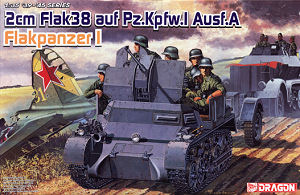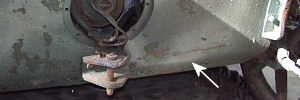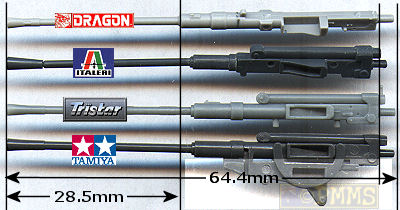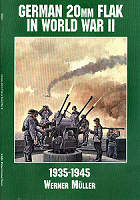

2cm FlaK38 auf Pz.Kpfw.1 Ausf.A
Flakpanzer I
Dragon Kit No. 6220
1:35th Scale
First Look Review by Terry Ashley


As the 1A is different in a number of aspects from the 1B the only part of this new kit from the previous 1B kits is the individual link track and while parts such as the drive sprocket and road wheels may look the same all have been reworked to some extent.
The kit consist of 343 parts in light grey plastic plus another 216 for the individual link track with 16 clear plastic parts, three small etched frets, three pre-formed brass parts plus the decal and instruction sheets.





The standard of moulding is again excellent with virtually no pin marks to contend with due to the now standard plastic “nodes” on the parts which will require care when removing from the finer parts.
The pre-formed brass parts are for the upper superstructure panel and two parts shell basket with the superstructure panel also including raised weld beads for a nice appearance.
As mentioned the all the parts for the Panzer 1A are new or reworked (except the track) while the two sprues for the 2cm FlaK38 are from the previous 2cm Flak38 kit #6288 with some minor modifications to a few parts.
There are also parts for a standard Panzer IA included but not used with this kit so we may be seeing further kits based on these parts.
Reference is fairly thin on the ground for the Flakpanzer I and therefore some details are difficult to check but the base Panzer I is well documented as is the FlaK38 so we can take things from there.
Lower Hull:
The lower hull is a conventional tub with separate front and rear panels with
panel and bolt head details on the bottom plate as well as axle and return
roller mountings on the hull sides.
The separate front panel has the final drive housing contours correct as well as the lower bolt heads and the underside weld seams on the final drive housings while the rear panel features a curved lower profile. This curve has a distict ridge at the curve point and not smooth as on the Dragon part and it also appears to be slightly too rounded than the actual curve but as this is very subtle and not easily seen on the finished kit is probably not worth worrying about.


On the real panel are the tail light and the large spring loaded towing pintle for the ammo trailer which also has additional etched parts.
The glacis plate at the front is separate part with the inspection hatch also a separate part with additional towing hooks and the central two part headlight and right side horn which is hollowed out with slide moulds.
Interior:
The lower floor is in two sections with the forward lower sections having one
axle channel with separate two part seat and driver’s levers as well
as the right side battery box that has a separate lid showing the battery
detail if you want to show open.
The separate driver’s foot pedals are added to a small raised plate with the fit of the floor sections to the lower hull being very good with cut-outs to position this around the lower tub axle mountings.
The rear raised fighting compartment floor has no tread plate pattern as it
should and no details on the sidewalls due to these being the insides of the
lower hull tub.
At the back is the fighting compartment bulkhead but the prominent starter
motor and tread plate cover are missing altogether.
The transmission and differentials are in multiple parts with nice detail overall but the differentials are a little basic but fit neatly in place and looks okay when viewed through the glacis inspection panel or the fighting compartment.
Suspension:
As mentioned this is not the same as in the IB kits with the road wheels, return
rollers and drive sprockets all being slightly reworked from the previous
parts.
The drive sprockets have smaller drive teeth and slightly larger rim bolts
while the road wheels have revised outer rims but the wheel cut-out profile
should be more rounded at the outer edges and on the first road wheel the small
hub cap is slightly the wrong profile and the small notches around the hub
missing but these are shown on the other road wheels.
The rear idlers are totally new for the IA and are made up of three parts each, the main wheel and two inserts that form the inner rim lip which looks very good on the assembled wheels. Unfortunately the idler wheels are 1mm oversized in diameter when compared to the 1:35 plans on the Achtung Panzer, Ground Power and Panzer Tracks books.
The axle bogies and springs are nicely done with well defined details but with fairly prominent mould seams to be removed which is easy enough with the return roller hubs also being refined from the previous parts.
Assembly of the suspension is very easy and precise with the fit of the parts actually holding the bogie units together without glue but of course you would glue them in place on the kit.
The Tracks:
These are all individual links with very fine details but being very small
will require some patience to assemble but the end result is excellent detailed
tracks.
While they are individual links they are not workable and have to be glued together but to help with this each link has small pins and corresponding grooves so each link will locate precisely into the next giving the correct spacing between each link and a positive seating, but be sparing with the glue so you don’t clog up the small spaces between the links.


Fenders:
The two main fenders are separate parts with fine tread plate pattern on the
top with a single bolted strip on the undersides and you have to open up the
applicable locating holes for the tools, exhaust and other details. At the
front are two small inside fender fillets that will need care fitting as the
location is not that precise and these govern where the main fenders are located.
There are separate front and rear fender sections with fine attachments with additional small wing nuts added while the tools have moulded on tool clips but there is also a sprue included with bare tools but no etched clips provided. These will make it easier to use any aftermarket etched tool clips set to improve the look.
The rear exhausts are in two parts with additional etched heat guards that are best annealed by running through a candle flame to make curving them to shape easier while at the front are two small lights and a nicely moulded NOTEK light for the left fender.
Upper Hull:
The forward superstructure panel has the formed brass upper superstructure
added to it and thankfully this is pre-bent to shape as the angles are quite
complex. Fitting the brass part to the plastic part did require a bit of
care as there is not a lot of contact area especially at the sides and I
also had the slightly bend the side angles a little to mate to the plastic
part but a lot easier than bending the brass from scratch.
Added inside the superstructure are clear parts for the visors and care will be needed using cyanoacrylate on the clear plastic and you can show the outer visor covers open or closed as you wish.
On the underside of the forward superstructure is the driver’s instrument panel with engraved dials that should look good with careful painting.
At the back is the distinctive Flakpanzer engine deck with large outlet holes on the rear panel added using slide moulds and the two side panel with five large holes provided as etched parts. This does leave join seams along the top of the panel needing filling which can be tricky when sanding between plastic and etched parts.
I have not seen a photo of the engine deck showing the hole arrangements or dimensions so can’t comment further other than to say the detail on the deck is nicely moulded and well defined. Added to the deck is the spare barrel box and upper rear panel.
The Flak gun base has fine tread plate pattern included with separate crew seats and folding side panels which can be fitted raised or lowered as required with the fit of the forward superstructure, flak base and rear engine deck being good but there may be some small gaps here and there which can be alleviated with careful fitting.
FlaK38 mit Sd.Ah.51 Trailer:
As mentioned this is mostly the same as with kit #6288 with a few minor updates
most notably the trailer wheels which now have the more common tread pattern
on the tyres and revised wheel rim details.
The lower turntable base has excellent details with a separate turntable with subtle tread plate pattern and around the edges of the base is the weld seam as it should be but unfortunately the sprue attachment points are right on the weld line and you will have to add back the small seam after cleanup for a uniform weld seam appearance.
The notable thing here are the four small tightening hand ‘wheels’ around the base which are superbly moulded with good definition especially considering the small size and really look the part. There are also etched wheels included as alternatives but these are best ignored as they are flat one dimensional and simply don’t look as good as the plastic items. It goes without saying that due to the small size extreme care will be needed when handling the small wheels.
The gunner’s seat is made up of six parts again with very good details and another small hand wheel on the back of the chair base.
The two gun cradle sides have separate upper bearing rings as per the real gun for good definition with additional separate parts for the elevation assembly and hand wheel plus the gunner’s foot rests and on the inside of the right cradle is a separate perforated reinforcing bracket and at the back is the rotation box and hand wheel.
The main gun sight is made up of five parts for excellent definition and the X stamped ammo clip container on the left side has three separate parts with the stamping on both sides.
The 20mm gun is moulded separate to the gun mount and also has a separate shell ejection chute cover while the flash suppressor is partially hollowed out with the six muzzle brake openings only represented by small indentations. There are three alternate chamber covers allowing different versions of the gun to be built.
The actual gun dimensions from the FlaK38 Technical Manual show that the kit
barrel is the correct length with just a minor discrepancy in the overall gun
length.
The measurements are; full length of the gun (housing and visible barrel including
flash suppressor) is 2252.5mm which equals 64.357mm in 1:35 scale and the visible
length of the barrel with flash suppressor is 995mm being 28.429mm in 1:35
scale.

There are alternate elevation arms and sight linkage rods to position the gun at 0°, 20°, 40° and 60° elevation with corresponding lower carriage panel for the applicable angle so you best make your choice of angle early on in the assembly.
The plastic gun shields are a little on the thick side with bevelled edges to give a thinner appearance and also include nice bolt head and attachment details with the upper and lower main shields as separate parts and new lower sections with the lower cut-outs to accommodate the superstructure but no etched shields are included with this kit as with the FlaK38 kit.
The shell ejection cage is included with plastic frames and etched mesh with the lower “basket” in two pre-formed halves and the upper sections that require you to bend to shape which is best done with your fingers to achieve natural contours and sag in the mesh and this should give a nice appearance.
The Sd.Ah.51 trailer is also very well done with the wheel mud guards included in the frame moulding but still have well defined details. The front trailer hitches have separate parts to allow the frame to be assembled raised or lowered depending on your choice.
The two wheels as mentioned have re-worked tread pattern and rim details and again no pin marks on either side of the wheel rims which are included on the outer wheel with just the inner tyre section as a separate parts making for a commendably thin wheel disc. On the inner rim is the tyre valve which protrudes through the hole in the wheel disk when the two wheel halves are fitted together for a good appearance.
The small storage box on the right fender is in three parts and can have the top shown open if required while there are other smaller details such as grab handles and other fittings for a good representation of the trailer.
There are additional ammo storage boxes to fit to the trailer in place of the gun when towed behind the vehicle.
Also included are spare 20mm ammo boxes and a spare barrel box with nice details included to add to dioramas.
Decals:
The small decal sheet has markings for two Flakpanzers with two additional
unmarked vehicles shown on the instruction sheet.
Three of the schemes are marked for Flak Abt.614 and one for an unidentified unit but as Abt.614 was the only unit to use the Flakpanzer I this notation is a little puzzling but you can just take it being for Abt.614.

The instructions are the usual exploded view line drawings that are quite busy in some places but are mostly east to follow.
Conclusion:
Overall this is very nice little kit with many excellent details throughout
with the discrepancies being in the minor category with the idler wheel diameter
being the most notably but most will just accept this as there is little alternative.
There is scope for additional detailing as with any kit but it will build into a nice model out of the box with the preformed brass parts making things a little easier.
Highly recommended.
The Sprues: Click on thumbnails for larger view










Detail images



Close new window to return to review
|
Panzer Tracts No 1-1
Panzerkampfwagen I Kleintraktor to Ausf.B |
Panzer Tracts No 1-2
Panzerkampfwagen I Kl.Pz.Bef.Weg, to VK 18.01 |
| German 20mm FlaK in WWII 1395-1945 By Werner Müller Schiffer Military History ISBN: 0-88740-758-7  |
Tamiya Photo Album 4 Tamiya Plastic Model Co. Krupp Protze Flak30, Flak38  |
| Ground Power Magazine Issue #071 April 2000 GALILEO Publishing Co.,Ltd.  |
Pz.Kpfw.I/Pz.Kpfw.II and variants Achtung Panzer No.7 Dainippon Kaiga Co.,Ltd..  |
Page created July 23, 2006